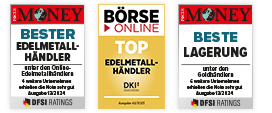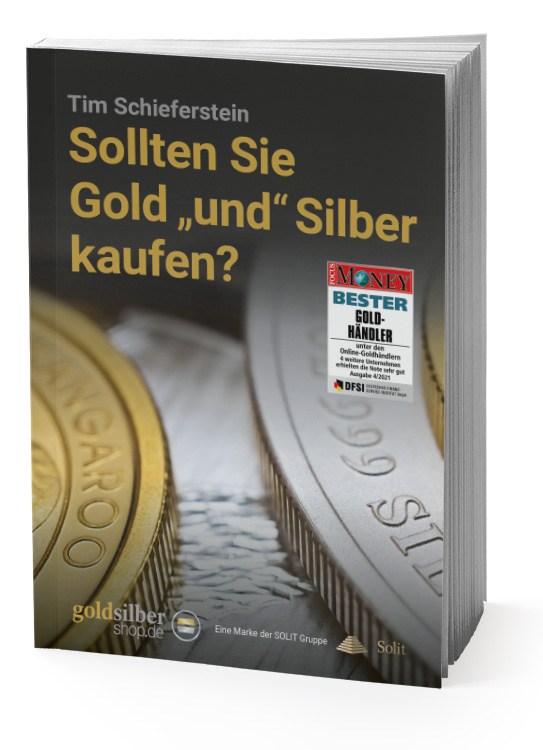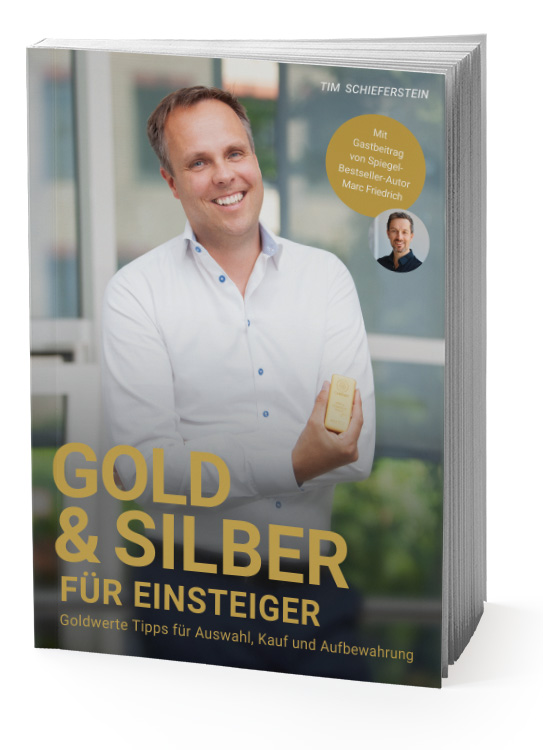Conclusion: Capital investment in gold and silver promising
In the following, the central results, theses and conclusions of this book are briefly summarized once again:
Geological basics
Origin: Heavy elements such as precious metals, however, were added to the Earth by impacting celestial bodies only in the course of its evolution.
Occurrence: The proportion of silver in the earth's crust is equal to the ratio of 1 to 15, but the average concentration is so low that economic mining is possible only in the case of massive enrichments. These extremely rare enrichments occurred under specific geological conditions, mostly involving hydrothermal processes combined with volcanic activity or sedimentation processes.
Resources: The underground gold and silver resources in 2009 were 0.1 million tons of gold and 0.57 million tons of silver, their ratio is thus about 1 to 6. Precious metals on the seabed or in seawater and their artificial production will never achieve economic significance due to the extremely high extraction costs involved.
Extraction and utilization
Mining: Precious metals have been mined and processed for six and a half millennia. Since then, 0.17 million tons of gold and 1.7 million tons of silver have been mined. Mining experienced a rapid increase, especially from the 19th century onwards, due to new mining technologies and an increasing demand for precious metals.
Precious metals as currency and store of value: In the 6th century BC, the legendary Croesus introduced gold and silver coins which, due to their properties of durability, rarity and divisibility, were the most important medium of exchange - money- for two and a half millennia. Due to increasing world trade, coins were replaced by paper money at the end of the 18th century for reasons of weight, but initially still backed by gold and silver. At the end of the 19th century, silver was initially demonetized, followed by gold in the early 1970s. The expansion of the money supply and debt that accompanied the pure paper money standard caused an increasing loss of confidence in the world monetary system, which brought the former monetary function of precious metals back into focus. Against this backdrop, they are highly valued as a store of value and an investment, and central banks are now net buyers of gold. In the meantime, there are even discussions about a new precious metal-backed world reserve currency.
Industrial demand:Industry accounts for one-tenth of gold demand, but half of silver demand due to silver's unique properties. Precious metals are likely to be in even greater demand in the future in most of today's industrial applications - boosted by the economic expansion of the emerging markets - and new applications with high precious metal requirements are also being discovered all the time. The price effects of increasing industrial demand for precious metals are particularly pronounced when this is associated with a large market and, at the same time, a low recycling potential.
Pricing
Supply and demand: In the case of gold, 64% of the supply (4.4 thousand tons) in 2011 resulted from mine production and 36% from recycling; in the case of silver (32.4 thousand tons), 73% resulted from mine production and 25% from recycling, and 1% each from government sales and sales via futures markets. For gold, 44% of demand was for jewelry, one-tenth each for industrial and central bank purchases, and 36% for coins, bars, and investments; for silver, 47% was for industrial, 6% for photography, 4% for silverware, 15% for jewelry, and 27% for coins and investments. Nine-tenths of gold demand and just under half of silver demand thus related to the accumulation of above-ground holdings, underlining their importance as stores of value.
Precious metal stocks: The hotly disputed level of above-ground stocks is derived from mine production minus the irretrievable losses resulting from precious metal consumption by industry and, in the case of silver, also by photography (from which the quantities recovered through recycling in these sectors must still be deducted). The physical gold preserved above ground in the form of bars, coins, jewelry and objets d'art corresponds to 0.15 million tons, or about 90% of the amount of gold ever mined, due to the comparatively low industrial importance of the metal. The ratio of above-ground physical gold to silver is thus 1 to 4.5.
Price development: After the inflation- and speculation-driven highs at the beginning of the 1980s, precious metal prices fell as a result of overcapacities and (apparently) abating inflation risks and stagnated for two decades. Due to high capacity utilization at the mines as a result of rising demand for precious metals from industry and the investment sector, higher mining and investment costs with declining mineralization grades of the deposits, a cap on gold sales and a ban on gold lending, as well as the increasing destabilization of the world financial and monetary system as a result of rampant debt and money supply expansion, persistently low interest rates and rising inflation expectations, precious metal prices entered an upward trend again at the beginning of this millennium. From their lows in 2001 to their interim highs in 2011, the price of gold increased eightfold and that of silver twelvefold.
Price-determining factors: The intrinsic value of precious metals depends on the abundance of deposits as well as on the labor and capital input required for their extraction. In the longer term, supply is oriented to marginal extraction costs, which are reduced by new extraction and recycling methods as well as new discoveries, and increased by the depletion of inexpensively minable resources and declining degrees of mineralization; demand is oriented to marginal utilization costs (foregone future profits from mining today), which are reduced by substitution effects and increased by a rising monetary function of precious metals, increasing inflation expectations and expanding industrial demand. Correlation analyses carried out show that the development of gold and silver prices benefits from low interest rates, a rising money supply and associated inflation expectations as an indication of declining confidence in the factually uncovered paper money system. In contrast, precious metal and stock market returns develop independently of each other.
Gold-silver ratio: For one and a half millennia, the gold-silver ratio - the relationship between the price of gold and silver - was 15, corresponding to the inverse ratio of the precious metal proportions in the earth's crust. Then, in the 20th century, it fluctuated between 15 and 100 (in October 2012, the gold-silver ratio was 52). The reason for the increase was that precious metals were now seen primarily as commodities due to the monetary function they had been deprived of, so the price ratio was more closely aligned with the level of extraction costs. In addition, gold was granted a monetary premium over silver due to central bank holdings. In the future, the scarcity ratios and the utility value of precious metals will come into greater focus. In accordance with the inverse ratio of the sum of the resources still available underground and the stocks above ground, a gold-silver ratio of 5 is to be regarded as a fair valuation ratio, which would then also more appropriately reflect the industrial and monetary significance of silver.
Gold and silver price projection: the 1980 gold price high corresponds on average - if different methods of deflation are used - to today's real gold price of US$5,000 per troy ounce (in October 2012 it was US$1,750). In the 1970s, the nominal gold price had increased twenty-fourfold by its high in early 1980. If it were to increase twenty-fold over the course of the current upward trend relative to the 2001 low, this would also result in a gold price of US$5,000. In the second half of the current decade, against the background of the expected supply and demand developments on the precious metals markets as well as distortions on the financial markets, a gold price of at least this level can be expected. Assuming a fair gold-silver ratio of 5 , this results in a silver price of US$1,000 per fine ounce of silver (US$33.5 in October 2012). The gold price would therefore have the potential to triple again in relation to the average in October 2012, while the silver price would have the potential to increase thirtyfold.
Impact of rising precious metals prices: Rising prices will result in additional production capacity being built due to increased investment in order to meet growing industrial and investment demand. Price-related substitution processes could also dampen the increase in demand. An improvement in the economic efficiency of recycling processes and an increase in the resource base can also be expected under changed technological and economic conditions as a result of price-induced technical progress, which will produce improved recycling, exploration and extraction technologies. New precious metal discoveries are conceivable as a result of increased exploration efforts, but this is only to be expected to a limited extent, especially in the case of silver, as its deposits are generally closer to the surface and are therefore probably already largely known.
Investment opportunities
Investments in physical precious metals can be jewelry, coins, bars or exchanged traded funds (ETFs), which are required to back their deposits with physical precious metals. Investments in mines or mining funds also open up opportunities, but also entail risks. Index certificates can be used to track the development of precious metal prices or gold and silver mining indices. Warrants can be used to leverage these changes so that a certain profit can be achieved with a small capital investment. Futures and options are suitable for institutional investors. Their trading in futures markets provides an early indication of a shortage of precious metals due to supply-side or demand-side factors. Conspiracy theorists imply that precious metal prices are deliberately manipulated through futures trading. However, without the hedge funds and speculators operating there, the precious metals markets would not function at all, because they supply liquidity to the markets and balance out the temporal, spatial and volumetric fluctuations in supply and demand.
Guide to buying gold and silver for free as an eBook
This guidebook is not so much about what mistakes you should avoid when buying gold and silver, but what are the differences and similarities or advantages and disadvantages of the two precious metals gold and silver in comparison? What to look for when buying gold or silver? How does the gold-silver ratio behave and where can you view this and much more red-hot information? You will receive our guide free of charge as a PDF file when you sign up for our newsletter.
Overall assessment
Gold and silver are rare, extremely valuable metals. This, like their extraterrestrial origins and unparalleled history as money, store of value, or jewelry, gives them a magical allure. To meet the expanding demand, precious metal production must therefore continue to rise. Even the multiplication of precious metal prices since the turn of the millennium has not changed the expansion of demand.
At the same time, underground precious metal resources are increasingly running out:
(1) In the coming years, therefore, improved extraction technologies and increased exploration efforts will have to expand the resource base. However, environmental regulations, rising energy prices and the depletion of easily minable, highly mineralized deposits will lead to an increase in the variable extraction costs per precious metal ounce; in addition, the investment and financing costs per ounce for the expansion or new construction of mines will also rise significantly.
(2) Underground gold resources are equivalent to only 36 years of gold production in 2011, and silver resources are equivalent to only 24 years of silver production. However, if mine production were to increase by 2% per year, even assuming a doubling of the underground resource base, gold resources would be depleted by 2056, and silver resources even by 2045.
(3) A similar picture emerges for aboveground stocks: Gold stocks correspond to 33 years of gold demand in 2011, while silver stocks correspond to only 21 years of silver demand. Thus, gold is less scarce than silver in terms of both underground resources and aboveground stocks.
(4) The ratio of resources and stocks between gold and silver (1 to 5) is steadily declining as the ratio of mine production (1 to 8) and demand (1 to 7) exceeds it. In addition, gold is primarily used for hoarding, while silver is irretrievably consumed to a significant extent due to high industrial demand, which is expected to expand even further in the future as a result of the dynamic economic growth of emerging countries and the ongoing discovery of new applications.
(5) Unlike gold deposits, enriched silver deposits are predominantly near-surface. Consequently, while silver is less costly to extract, it is also less likely to be newly discovered, as silver deposits are likely to have been largely discovered already.
In view of a gold-silver ratio of over 50 (October 2012), the findings suggest a significantly higher silver price in relation to the gold price. However, silver price development will also benefit from the fact that the remonetization of precious metals has so far been priced more into the gold price than into the silver price. Silver therefore has great catch-up potential in this respect as well.
The following argue for a further increase in the monetary importance of precious metals:
(1) Distortions in the world financial system, escalating debt, massive monetary expansions and high inflation expectations will undermine confidence in paper currencies and further push net investments in tangible assets such as gold and silver, which already started at the turn of the millennium. In addition, income increases and the growth of a high-income middle class in the emerging markets will spur demand for precious metal jewelry, commodities, coins, medals and bars as inflation-proof assets and stores of value.
(2) Since 2001, all major world currencies have depreciated against gold and silver at an average annual rate in the double-digit percentage range, which indicates that precious metals are increasingly being seen again as a generally accepted world currency. This is also supported by the fact that against the background of the financial market crisis of 2008/2009 and the sovereign debt crisis of 2011/2012 - inspired by the emerging markets, among other things - there is increasing discussion of a new precious metal-backed world reserve currency.
(3) Since 2010, central banks worldwide have been buying more gold than they are selling. The reason for this is, on the one hand, that the central banks of the most important industrialized countries already committed themselves contractually at the turn of the millennium to limit their gold sales and to refrain from gold lending, which has a strong price-dampening effect; on the other hand, the emerging countries are endeavoring to shift their currency reserves, which are allocated to a relatively small extent in precious metals, partly into gold, but also into silver.
(4) The persistently low interest rates since the turn of the millennium have a positive effect on precious metal prices, as they reduce the profitability of alternative investments and thus the opportunity costs of precious metal investments. Moreover, the official inflation measure does not adequately express the actual inflationary pressures. The more the broad masses become aware of this, the more confidence in the paper money system is likely to diminish further.
(5) Over the past three decades, the annual increase in the money supply M3 of the OECD countries was on average 5 times as high as the increase in gold and 8 times as high as that in silver. While paper money can be multiplied arbitrarily and at almost zero cost, the extraction of precious metals involves costs, so that unlike paper money they have an intrinsic value, plus a considerable use value.
So who does the future belong to, gold or silver? Both, because both gold and silver prices will continue to rise significantly in the coming years against the backdrop of increasingly depleting precious metal reserves, as well as further expanding investment and industrial demand in light of the increasingly fragile financial system and the dynamic growth of emerging markets. However, the key findings of this book indicate that this will be even more pronounced for the silver price compared to the gold price.
Book & eBook "Gold & Silver for Beginners" free for you
"An exciting and educational book that will spark interest in investing in precious metals even for people like me who have never looked into this topic before." - Concluded the editor, who subsequently bought gold for the first time.
What are the pros and cons of precious metals? Which bars and coins are recommended and why? What are typical beginner mistakes and how can you recognize a reputable precious metals dealer? Where and how to store precious metals safely? To these and many other questions (not only) beginners will find answers and tips in this approximately 200 pages comprehensive basic reading of precious metals expert Tim Schieferstein on the subject of gold and silver.
With this book we would like to carry out clearing-up work and make so the entrance into a capital investment in precious metals easy. Therefore GoldSilberShop.de gives both the eBook and the printed book to you! Secure your copy today!







